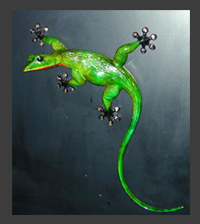 I was watching TV with Donovan, Modern Marvels to be exact and they had a short segment about Gecko’s and how their feet are the holy grail of climbing devices. They featured Stanford’s Sticky Bot (here’s a YouTube clip), which gets its ability to scale walls and other smooth surfaces through Directional Adhesion. Directional Adhesion is made possible by basically having thousands of tiny strands that keep the bot from sliding downward (in a single direction), but as soon as you pull it upwards – it loses all of it’s adhesion capabilities.
I was watching TV with Donovan, Modern Marvels to be exact and they had a short segment about Gecko’s and how their feet are the holy grail of climbing devices. They featured Stanford’s Sticky Bot (here’s a YouTube clip), which gets its ability to scale walls and other smooth surfaces through Directional Adhesion. Directional Adhesion is made possible by basically having thousands of tiny strands that keep the bot from sliding downward (in a single direction), but as soon as you pull it upwards – it loses all of it’s adhesion capabilities.
The Gecko gets its ability to climb from millions of hairs, known as setae on the pads of their feet. These hairs are so small that there is an electrostatic interaction with the object they are climbing, called the van der Waals effect. This is pretty amazing. I never really put a whole lot of thought into a gecko and how they climb, or other insects for that matter, but the speed at which a Gecko can scale a glass wall is astounding; several meters in a matter of seconds.
There are also folks at the University of Akron and Rensselaer Polytechnic Institute, who have been working with Carbon nanotubes to mimic the setae on the feet of a Gecko, having very positive results. Engineers at Berkeley have also had good results creating a polymer based materials (Gecko Tape) using the ideas and structure of a Geckos setae as the foundation. These microfiber strips are remarkably strong, and hold weight far heavier than size of the material would suggest possible; although the Berkeley teams are still working with Directional Adhesion.
The applications of such a material or device could be quite astounding. Just imagine a machine that would allow rescue workers to literally scale the wall of a High Rise Building to rescue people trapped in the top levels by a fire. Or have the ability to create a bridge between two buildings, allowing people to escape from a burning High Rise to a safe, neighboring one. Mountain rescues could even benefit from this technology, allowing rescue climbers to be able to scale an ice wall without the use of crampons and ice-axes.
Even now, a large version of Stanford’s sticky bot could be used to effect rescues from tall buildings, an autonomous robot 10 to 20 times the size (of the current sticky bot) would likely be able to hold several hundred pounds above its own weight, and be able to lower people down a cable to safety.
I have never wanted to be a lizard this much in my life as much as I do now.
